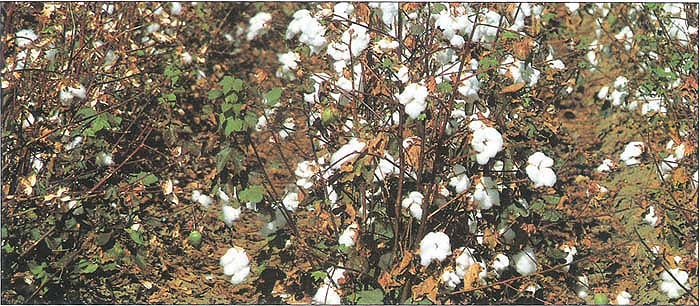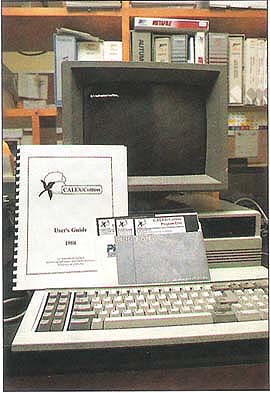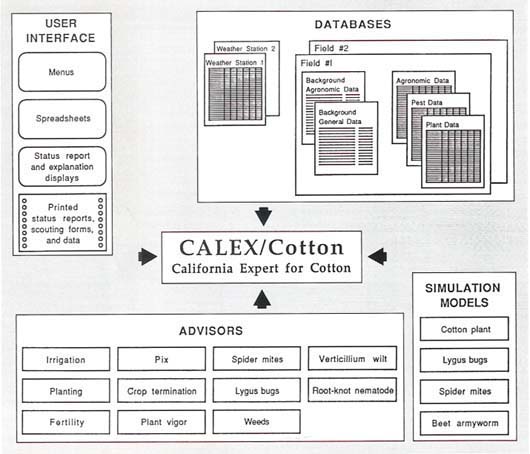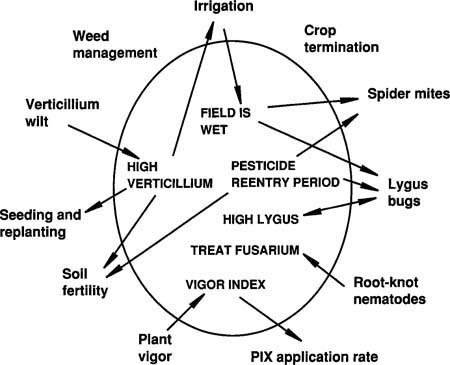All Issues
IPM: CALEW Cotton: an integrated expert system for cotton production and management
Publication Information
California Agriculture 44(5):18-21.
Published September 01, 1990
PDF | Citation | Permissions
Abstract
CALEX/Cotton is a user-friendly computer program that simulates human problem-solving behavior. Growers can use this system to help manage crop production or predict the effects of any one decision on subsequent events. In 7990, more than 700 cotton producers have taken advantage of the CALEW Cotton computer program.
Full text
Production of any crop requires many decisions before and during the growing season. Keeping track of all the information required for management or predicting what the influence of any one decision might have on subsequent decisions is difficult. Also, incorporating new knowledge and technology into existing farming practices is a slow process, requiring careful consideration to avoid any adverse side effects.
Integrated expert systems are computer programs that hold promise for managing and coordinating the information required for optimal crop production. Expert systems simulate the problem-solving behavior of a human who is an expert in a narrow area. The knowledge base of agriculture is anything but narrow, and rarely is there only one solution available for a particular problem. An integrated expert decision-support system can help a grower make decisions that involve several alternatives, and can address several, often competing factors. These computer programs combine database management, regression models, simulation models, and rule bases (a rule base is like an “advisor:“ it contains knowledge in a format conducive to problem solving).
Components and development
Since 1986, the Statewide IPM Project has funded the development of a prototype integrated expert decision-support system for crop production. A program shell was developed for use on many crops. That shell, CALEX (CALifornia EXpert), provides for data input, manages information within and between the various components, and supports a modular rule base structure and simulation models (fig. 1). San Joaquin Valley cotton production was chosen for the initial application of this technology because of the comprehensive knowledge base, history of crop simulation, and interest by the industry, and because of the willingness of a team of research, extension, and industry personnel to work together.
CALEX/Cotton contains plant and pest simulation models that are unique in their ability to provide accurate output in response to real field data. Predicting all field conditions in a model is impossible; even the most sophisticated model cannot account for all physical and biological factors that determine the growth and development of a crop or the population dynamics of several pests.
Our approach was to model the cotton crop and its pests with a high degree of biological realism by using adaptive algorithms that adjust parameters dealing with vegetative growth, fruit survival, and insect survival and fecundity. These models now predict yield, numbers of fruit (squares and bolls), numbers of mainstem nodes (an important parameter in many decisions), and numbers of nodes above white bloom (a parameter useful in late-season decisions). They simulate spider mite, lygus bug, and armyworm populations based on initial population estimates and incorporate their feeding into the plant mode. As yet there are no strong linkages between the simulation and the rule bases, but these are planned for future versions.
Information in the rule bases represents a consensus of cotton specialists, including university and industry experts. Industry cooperators also helped determine which rule bases should be developed and helped prioritize their development. Each rule base represents an advisor on a particular management practice, and each can easily be modified.
Each rule base advisor operates in isolation from other rule base advisors, but has access to common information via a “blackboard” (fig. 2) and supplies its own conclusions for use by other rule bases. For example, if an irrigation schedule is generated, advisors for lygus and mites can check for potential pest management conflicts. If conflicts exist, the advisors can modify their advice and resolve the conflicts.
CALEX/Cotton, the Statewide IPM Project's expert system for cotton production, runs on MS-DOS computers. The program is available free from IPM.
The current version of CALEX/Cotton contains 14 rule base advisors: (1) spider mites (Tetranychus complex), (2) lygus bugs (Lygus hesperus), (3) root-knot nematodes (Meloidogyne incognita), (4) Verticillium wilt (Verticillium dahliae), (5) weed management, (6-8) fertility (nitrogen, phosphorous, potassium), (9) irrigation scheduling, (10-11) planting (seeding rate and replant), (12) application of a plant growth regulator (PIX), (13) crop termination, and (14) plant vigor. These advisors are used as the season progresses from preplant decisions through crop termination decisions. Many advisors are active only during appropriate calendar or phenological periods. For example, the lygus advisor will not operate until sufficient degree-days have been accumulated for the initiation of fruiting positions (squares).
Rule bases and simulation models both rely on daily air temperatures, precipitation, solar radiation, and reference evapotranspiration. As a default, CALEX/Cotton weather files contain 30-year averages calculated with data from a San Joaquin Valley National Oceanic and Atmospheric Administration cooperative station. This ensures that files will have data for each day and allows for biological predictions based on averages. As the season progresses, actual weather data are used to improve the predictions. Data can be entered manually or transferred from the comprehensive weather database at UCIPM.
Early season
CALEX/Cotton can be used early in the season to make preplant pest management decisions for nematodes, Verticillium wilt, or fallow bed weed management. At the time of planting, the seeding rate may be adjusted according to desired plant density, the variety, seed germination percentage, and the predicted degree-day accumulation over the next 5 days.
If conditions have not been ideal for plant emergence, a producer may wish to evaluate the plant density and consider replanting. The replant rule base considers four factors: plant density, degree of chilling injury (total degree-days during first 5 days following planting), “skippiness” of the stand (percentage of row with more than 3 feet between plants), and calendar date. In the decision to replant, a decreased yield potential resulting from a poor stand and some chilling injury is compared to the reduced yield caused by a late planting. A break-even date is calculated, and if replanting cannot be accomplished by that date CALEX/Cotton advises that the existing stand be retained.
Fig. 1. The program draws on decision-making rule base “advisors” and a variety of databases, and then uses computer models to simulate crop growth under the prescribed conditions.
Midseason
Production and pest management activities get into full swing after May. During this period, CALEX/Cotton can help with weed, spider mite, and lygus management, irrigation scheduling, plant fertility, and use of PIX.
Lygus bugs are key insect pests that reduce yield potential by damaging squares (flower buds). The lygus bug advisor adjusts its rules depending on the number of degreedays accumulated from planting and the type of data available. From the onset of squaring until 75,000 squares per acre are present, lygusbug control decisions are based on field samples representing the average percentage square retention in the top five nodes of the cotton plant.
To estimate the plant's ability to compensate for lost squares, the program calculates, based on location, the maximum degree-days available between the first square and the last square that will produce a harvestable boll. Based on the fraction of damaged squares in the top five nodes of the plant and this compensatory factor, the lygusadvisor determines whether the damage is sufficient to cause a yield reduction. This approach results in optimal pest managment decisions for a given location.
Fig. 2. CALEX/Cotton contains many rule base “advisors” (listed outside circle) that interact with each other through the “blackboard” (information inside circle). Interaction between advisors is shown by arrows.
The missing square data are also used by the lygus simulation model to estimate the number of lygus before the time when sweep nets can reliably estimate lygus populations. This allows the simulation to predict subsequent population patterns and damage.
Later lygus treatment decisions are based on the conventional lygus-to-square action threshold. This technique relates the total number of squares per meter of row to an action threshold of three bugs per 50 sweeps per 100 squares. If total square data are not available, an absolute threshold of 10 bugs per 50 sweeps is used.
The timing of irrigations is critical to many production activities. A season's irrigation schedule is based on available pressure bomb readings. The program fits a regression line to the pressure bomb readings and uses this line to forecast future leaf water potential. If no pressure bomb data are available, a water budget method is used: based on weather data, evapotranspiration is estimated and the soil moisture level is computed daily. When the forecast soil moisture equals the allowable depletion, an irrigation is scheduled.
The use of PIX as a plant growth regulator has become widespread. This tool can be used to manage plant height in a way that will encourage square and boll set. Factors important in determining whether an application is warranted include node number of first fruiting branch, early fruit retention, date of planting, and vigor index. The vigor index is an expression of the relation between the number of mainstem nodes and the plant height, and is a valuable indicator of plant stress. Attempting to link these factors without the aid of a computer would be extremely difficult. The PIX advisor is the first rule base developed specifically to take advantage of the computational and data management powers of CALEX/Cotton.
Late season
CALEX/Cotton provides useful late-season advice for weed management, crop termination, and scheduling the final irrigation. The weed management module is patterned after an advisory program developed by David Cudney, Extension Weed Specialist at UC Riverside. This advisor provides weed management advice for each of five periods in the cotton season: (1) fallow bed, (2) preplant incorporated, (3) postemergence, (4) lay-by, and (5) preharvest.
Besides listing nonchemical controls, the program can evaluate the efficacy of an herbicide against a users's selection of weeds, or list weeds controlled by an herbicide selected by a user. This information is based on herbicide efficacy tables that appear in the IPM for Cotton manual and in other publications. The list of available herbicides may be modified based on information about local conditions provided by the user. Important label information is provided in a succinct format.
The crop termination advisor helps to project the date of defoliation by using the number of nodes above the highest white bloom. Three field observations are required for a regression analysis that predicts the date when the number of nodes above white bloom will be reduced to four. Defoliation is scheduled 725 degree days (base 50°F) after this date.
Implementation
Central to the development of CALEX/Cotton has been the delivery of the program to its users. From the beginning, local producers and pest control advisors (PCAs) have been involved in its development, providing expertise and evaluation. Each succeeding year's version of the program has been progressively more complex. Beginning in 1988, CALEX/Cotton has been available at no cost to anyone requesting a copy. Approximately 400 copies of the program were distributed in 1988 and 1989 to producers, PCAs, private crop consultants, and government agencies.
The distribution of the program is coupled to training sessions that provide general instruction in program use. In 1989, monthly user group meetings were held in three locations in the San Joaquin Valley to provide user support, technical assistance, and suggestions for use during the four weeks that followed. These monthly meetings eliminated the need for an intensive training session and allowed us to subdivide training into smaller, relevant portions. In the 1990 season, these meetings were linked to monthly cotton production meetings, thus increasing the potential audience.
As part of the program's development, we produced a detailed user manual that covers instructions for using the program and sampling techniques for collecting the data required by the program. Monthly newsletters have been provided to augment the manual and provide suggestions for using CALEX/Cotton.
We surveyed users by telephone and mail to determine which components of the program were being used, the frequency of use, the usefulness of the advice, and suggestions for improvements. In 1989, only 25% of the users responded to mail survey. The agronomic rule bases were rated very useful to fairly useful by 50% of those responding. Only 40% rated pest management rule bases in this way. The difference in ratings might reflect the nature of the decisions being made. Often, pest management decisions can be made in the field after a brief evaluation of the sample data. Agronomic decisions tend to be interlinked with other activities, and expert advice mighthelp to handle this complexity. In addition, pest problems (such as root-knot nematodes) are not always widespread, and thus are not of general interest.
Ninety-five percent of those responding said CALEX/Cotton was very easy or fairly easy to use. About 90% responded that available support was very valuable or fairly valuable. Even though CALEX/Cotton was designed to be easy to use, we found it necessary to provide fundamental computer literacy training.
CALEX/Cotton has been well received by the cotton industry. Because of the close involvement of the industry during the development of the program, its strengths and limitations are appreciated by those using it. The program is recognized as a prototype with much development yet to occur and the full potential of the technology yet to be realized.
Expert support systems hold the promise of acting as a conduit to improve the flow of technology and knowledge from researchers to agriculturists. Demands for more information in this new decade will require new methods for handling information. Economic constraints and legal restrictions will continue to increase and will increasingly require that agricultural chemical inputs be justified. CALEX technology can meet this challenge by taking a systems approach to managing data and information that encompass as much of the production system as possible.








